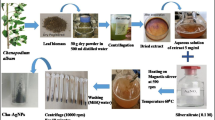Abstract
Silver nanoparticles are potent antimicrobials and could be used as a promising alternative of conventional antibiotics. The aim of this study was to isolate bacteria from soil that have ability to produce AgNPs by secondary metabolite activity and their elucidation against human pathogens. These strains Escherichia coli, Exiguobacterium aurantiacumm, and Brevundimonas diminuta with NCBI accession number MF754138, MF754139, and MF754140 respectively were grown for secondary metabolite production. The nanoparticles were confirmed and characterized by UV-Vis spectroscopy and transmission electron microscopy. The optimization study was also carried out to obtain the maximum production of silver nanoparticles. Three parameters, temperature, pH, and AgNO3 concentration, were used to optimize the production of silver nanoparticles. Antimicrobial potential of these nanoparticles was addressed on the Muller-Hinton Agar, and their zones of inhibitions were measured. TEM analysis revealed the size and shape of the silver nanoparticles. All types of AgNPs were spherical in shape; their size range is from 5 to 50 nm. The findings of optimization study showed the maximum production of silver nanoparticles at the pH 9, temperature 37 °C, and 1 mM AgNO3 concentration. All the strains exhibited the great potential as antimicrobial agents against MRSA and several other MDR bacteria with minimum 10 mm to maximum 28 mm zone of inhibition. It was concluded that the present study is an eco-friendly approach for the synthesis of AgNPs that will be beneficial to control the nosocomial infections triggered by MRSA and other human pathogens.








Similar content being viewed by others
References
Awwad AM, Sale NM, Abdeen AO (2013) Green synthesis of silver nanoparticles using carob leaf extract and its antibacterial activity. Int J Infect Control 1:29
Deljou A (2016) Green extracellular synthesis of the silver nanoparticles using thermophilic Bacillus sp. AZ1 and its antimicrobial activity against several human pathogenetic bacteria. Iran J Biotechnol 14(2):25–32
Gandhi H, Khan S (2016) Biological synthesis of silver nanoparticles and its antibacterial activity. J Nanomed Nanotechnol 7:366
Gowramma B, Keerthi U, Rafi M, Rao DM (2015) Biogenic silver nanoparticles production and characterization from native stain of Corynebacterium species and its antimicrobial activity. 3 Biotech 5(2):195–201
Hayakawa M (2008) Studies on the isolation and distribution of rare actinomycetes in soil. Actinomycetologica 22(1):12–19
Iravani S (2014) Bacteria in nanoparticle synthesis: current status and future prospects. International scholarly research notices
Krishnaraj C, Jagan EG, Rajsekar S, Selvakumar P, Kalaichelvan PT, Mohan N (2010) Synthesis of silver nanoparticles using Acalypha indica leaf extracts and its antibacterial activity against water borne pathogens. Colloids Surf B: Biointerfaces 76(1):50–56
Muthukumaran U, Govindarajan M, Rajeswary M, Hoti SL (2015) Synthesis and characterization of silver nanoparticles using Gmelina asiatica leaf extract against filariasis, dengue, and malaria vector mosquitoes. Parasitol Res 114(5):1817–1827
Okafor F, Janen A, Kukhtareva T, Edwards V, Curley M (2013) Green synthesis of silver nanoparticles, their characterization, application and antibacterial activity. Int J Environ Res Public Health 10(10):5221–5238
Paul D, Sinha SN (2014) Extracellular synthesis of silver nanoparticles using Pseudomonas aeruginosa KUPSB12 and its antibacterial activity. Jordan J Biol Sci 7(4):245–250
Priyadarshini S, Gopinath V, Priyadarshini NM, MubarakAli D, Velusamy P (2013) Synthesis of anisotropic silver nanoparticles using novel strain, Bacillus flexus and its biomedical application. Colloids Surf B: Biointerfaces 102:232–237
Rai MK, Deshmukh SD, Ingle AP, Gade AK (2012) Silver nanoparticles: the powerful nanoweapon against multidrug-resistant bacteria. J Appl Microbiol 112(5):841–852
Rajora N, Kaushik JA, Kothari SL (2016) Rapid synthesis of silver nanoparticles by Pseudomonas stutzeri isolated from textile soil under optimised conditions and evaluation of their antimicrobial and cytotoxicity properties. IET Nanobiotechnology 10(6):367–373
Saravanan M, Barik SK, MubarakAli D, Prakash P, Pugazhendhi A (2018) Synthesis of silver nanoparticles from Bacillus brevis (NCIM 2533) and their antibacterial activity against pathogenic bacteria. Microb Pathog 116:221–226
Singh R, Wagh P, Wadhwani S, Gaidhani S, Kumbhar A, Bellare J, Chopade B (2013) Synthesis, optimization, and characterization of silver nanoparticles from Acinetobacter calcoaceticus and their enhanced antibacterial activity when combined with antibiotics. Int J Nanomedicine 8:4277
Singh D, Rathod V, Ninganagouda S, Hiremath J, Singh AK, Mathew J (2014) Optimization and characterization of silver nanoparticle by endophytic fungi Penicillium sp. isolated from Curcuma longa (turmeric) and application studies against MDR E. coli and S. aureus. Bioinorg Chem Appl
Sunkar S, Nachiyar CV (2012) Biogenesis of antibacterial silver nanoparticles using the endophytic bacterium Bacillus cereus isolated from Garcinia xanthochymus. Asian Pac J Trop Biomed 2(12):953–959
Suresh U, Murugan K, Benelli G, Nicoletti M, Barnard DR, Panneerselvam C, Chandramohan B (2015) Tackling the growing threat of dengue: Phyllanthus niruri-mediated synthesis of silver nanoparticles and their mosquitocidal properties against the dengue vector Aedes aegypti (Diptera: Culicidae). Parasitol Res 114(4):1551–1562
Wiley BJ, Im SH, Li ZY, McLellan J, Siekkinen A, Xia Y (2006) Maneuvering the surface plasmon resonance of silver nanostructures through shape-controlled synthesis. J Phys Chem 110:15666–11567
Acknowledgments
The authors would like to thank Department of Microbiology and Molecular Genetics, The Women University Multan and Higher Education Commission Pakistan for providing support and all the facilities.
Author information
Authors and Affiliations
Corresponding authors
Additional information
Responsible Editor: Philippe Garrigues
Publisher’s note
Springer Nature remains neutral with regard to jurisdictional claims in published maps and institutional affiliations.
Rights and permissions
About this article
Cite this article
Saeed, S., Iqbal, A. & Ashraf, M.A. Bacterial-mediated synthesis of silver nanoparticles and their significant effect against pathogens. Environ Sci Pollut Res 27, 37347–37356 (2020). https://doi.org/10.1007/s11356-020-07610-0
Received:
Accepted:
Published:
Issue Date:
DOI: https://doi.org/10.1007/s11356-020-07610-0




